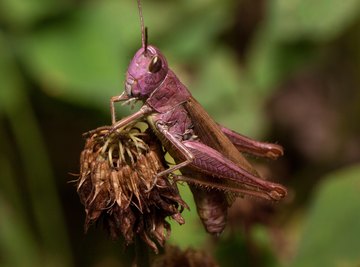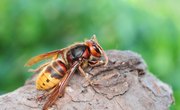
If you were able to see a grasshopper's mouth up close, it might look like something from a science fiction film. But if you ignore its strange appearance, you would see that the mouth is perfectly designed for cutting and chewing plant material. Unlike predatory insects, whose mouths are aimed forward to grab prey, a grasshopper's head is oriented downward, perfectly positioning the mouth for easy access to leaves, stems, seeds and flowers.
TL;DR (Too Long; Didn't Read)
TL;DR: Grasshoppers are typically herbivores, eating almost all parts of a plant, but some species have been known to eat other insects and even dead mammals.
Identification
Grasshoppers belong to the group of insects called Orthoptera, which also includes crickets and katydids. The most common grasshoppers are the short-horned grasshoppers, or Acrididae, with large hind legs for jumping and short antennae. Their chewing mouth parts, known as mandibles, move side to side with sharp, scissor-like edges and flatter surfaces for grinding their food. Other mouth parts, called maxillae, act like forks and spoons to help handle the food.
Life Cycle
While some insects such as beetles and butterflies have very different immature forms, young grasshoppers, called nymphs, hatch from eggs looking like smaller versions of their parents. At this stage they are incapable of flying as their wings are absent or not fully developed. Over approximately eight weeks, the nymphs molt and grow until they become adults with fully functioning wings and genitalia. Throughout this time, nymphs continuously feed on nearby plants.
Diet
Grasshoppers aren't particularly selective about what they eat, but they often favor green leaves. When grasses, plant stems and flowers are scarce, grasshoppers have no problem eating fungi, moss, animal dung, rotting meat, and weakened insects or spiders. If you have found a grasshopper outdoors and would like to observe it eat for a while, any available greens that you have at home such as well-washed lettuce, kale or cabbage would be suitable food.
Habitats
As the name would suggest, grasshoppers prefer to live in grassland and rangeland habitats. Female grasshoppers lay their eggs in the undisturbed soil of fields and meadows. The eggs remain there over the winter and hatch in late spring. If there is enough food in the area, they can remain there throughout the summer. When food becomes scarce, grasshoppers can become serious pests by migrating to other areas like farms and gardens, and feeding on vegetables, fruits, flowers, trees and grasses.
Locusts
Most grasshoppers are solitary, but when there are many individuals in one location, some species, known as spur-throated grasshoppers, aggregate into groups and migrate long distances. These "locust" swarms can contain millions of individuals and can be devastating to farms and orchards in their path. Today and throughout history, locust plagues have been responsible for food insecurity and famines affecting millions of people across the globe.
References
About the Author
Ms. Jean Godawa is a former science educator and freelance writer with a degree in biology and environmental science. She is fascinated by insects, and conducted field research in the rainforests of South America and South East Asia. She contributes science and nature articles to online and print publications including ONNature, Trellis and The Globe and Mail.
